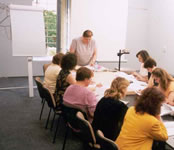Speaking or presenting
in front of people can be a daunting experience . Fortunately
becoming a confident presenter is often only a matter of
practice and hard work.
 Let's look at some practical ways that you can help yourself to develop better
presentation skills and over time, become a good speaker. Let's look at some practical ways that you can help yourself to develop better
presentation skills and over time, become a good speaker.
Prepare your presentation
Presentation guru Dale Carnegie says that
a prepared speech is “nine tenths delivered”. It is important
to remember that even if you know your subject matter well,
you still need to sift through all of the material to meet
the specific needs of your audience.
Know the Purpose of your Message
One of the keys of successful presenting
is having a valuable message to send. Therefore it is imperative
that you identify;
- The purpose of the message that
is to be delivered
- The desired outcome of delivering
this message
- What the audience wants or needs to
know
For your message to make an impact, you
must identify what the audience should DO, SAY
or THINK as a result of listening to your presentation.
Presentation
Purpose Planner [pdf]
Know your Audience
In order to make an impact on the audience
and for them to listen to your message Habit 5 from Stephen
Covey's “The 7 Habits of Highly Effective People” suggests
you should “seek first to understand, then to be understood.”
Designing your message specifically to
meet the needs, experiences and learning style of the audience
requires an understanding of their worldview. Knowledge
of the audience may also help you to be prepared for dealing
with company politics or anticipate future questions.
Audience
Analysis Planner [pdf]
Uderstand the Communication
Process
Communication is a two-way process. As
a presenter you have a message that you want to share with
your audience, so select the most appropriate way to send
that message. As you share your message, your audience
will return you some form of feedback. Both of you will
react in some way to what you hear, see or say. Therefore,
it is important as a presenter to focus on the feedback
and reactions of your audience and not just on sending
the message. Be aware that blocks may prevent or distract
your audience from receiving the message in the way that
you intended. Some examples of common blocks include:
- Physical Setting -
noises in/outside of the room, poor lighting or sound,
hot/cold, mobile phones, people moving about the room.
- Your
Presentation Style -
the way you speak, the words you use, your
posture, the way you design the presentation
all may prevent people from listening or getting
your message.
- People
Blocks - Ideas,
values, experiences or opinions of the audience
may prevent them from receiving the message
in the way that you intend. Therefore, the
more you know about the audience before you
present helps you to prepare or over come these
blocks or objections on the day.
Logistics Planner [pdf]
Continue
to page 2>

|

